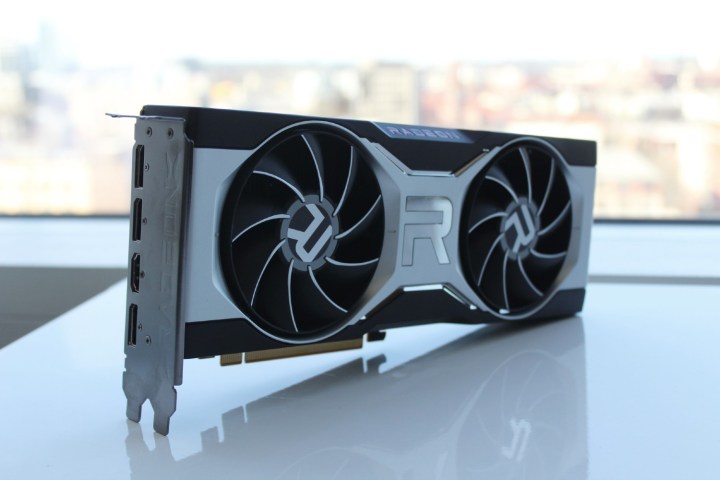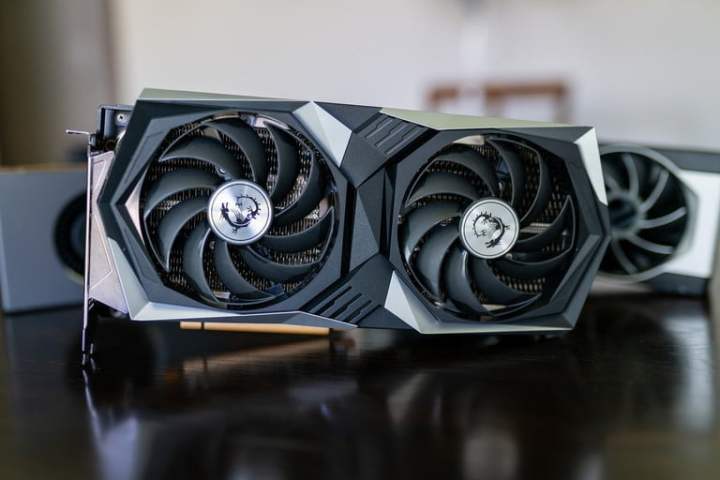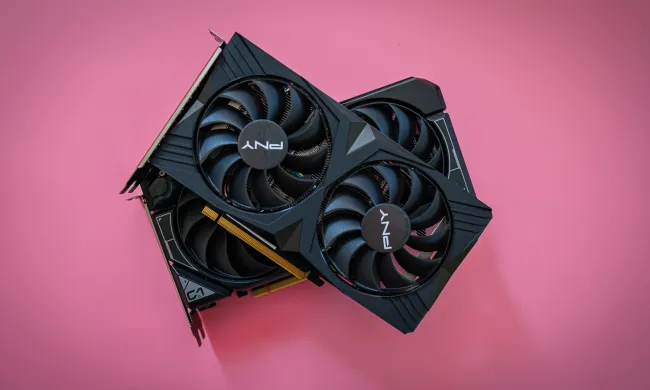The AMD RX 6600 XT, RX 6700 XT, and RX 5700 XT are all targeting the same range of gamers. These cards shine at 1080p and 1440p, delivering smooth frame rates in even the most demanding titles. But which one is right for you?
Although all three cards target the same crowd, they aren’t built equally. Some key differences in price, performance, and extra features separate the cards into a clear ranking, with the RX 6700 XT taking the lead.
Pricing and availability

AMD launched the RX 5700 XT on July 7, 2019, for $399, but a new card can cost as much as $1,200 as of August 2021. Pre-owned cards sell for a little less, but they’re still a few hundred dollars above the launch price.
The RX 6700 XT was released on March 18, 2021, for $479. The cheapest card in the RX 6000 range, the RX 6600 XT, arrived on August 11 for $379. Like the 5700 XT, neither of these cards is selling for its list price.
Thankfully, the new range is slightly cheaper. The RX 6700 XT is selling for about $700 on the secondhand market at the time of publication.
The GPU shortage has caused inflated prices almost across the board, and cards haven’t recovered quite yet. Although there are plenty of graphics cards available, demand is still high, and the price of manufacturing has risen, leading to cards that are much more expensive than their list prices.
Specs
The RX 6600 and RX 6700 XT are built on AMD’s RDNA 2 architecture, so we can draw some direct comparisons between them based on specs. The older RX 5700 XT uses a last-gen architecture, but its specs still reveal some interesting details in relation to the newer cards.
| RX 6600 XT | RX 6700 XT | RX 5700 XT | |
| GPU | Navi 23 | Navi 22 | Navi 10 |
| Interface | PCIe 4.0 | PCIe 4.0 | PCIe 4.0 |
| Architecture | RDNA 2 | RDNA 2 | RDNA |
| Stream processors | 2,048 | 2,560 | 2,560 |
| Ray tracing accelerators | 32 | 40 | 0 |
| Base clock | 1,968MHz | 2,321MHz | 1,605MHz |
| Boost clock | 2,539MHz | 2,581MHz | 1,905MHz |
| Memory | 8GB GDDR6 | 12GB GDDR6 | 8GB GDDR6 |
| Bandwidth | 256GBps | 384GBps | 448GBps |
| Memory bus | 128-bit | 192-bit | 256-bit |
| TDP | 160W | 230W | 225W |
Starting with the two newer cards, the RX 6600 XT and RX 6700 XT comprise the lowest two steps of AMD’s RX 6000 range. The differences between them are clear — the RX 6600 XT sheds eight compute units (CUs) for 512 fewer stream processors, and it comes with 4GB less of GDDR6 memory.
It doesn’t boost quite as high as the RX 6700 XT, either, but that shouldn’t make a huge difference in games. The bigger difference comes from the memory interface. The RX 6600 XT uses a 128-bit bus, leading to much lower memory bandwidth.
That’s why the RX 5700 XT has much higher bandwidth despite having less memory. Compared to the other cards, it’s markedly slower despite sporting the same number of cores as the RX 6700 XT. That’s AMD’s last-gen architecture at work.
It’s missing ray accelerators, too. The RX 6000 cards include a ray accelerator in each compute unit, while the RX 5700 XT lacks hardware-accelerated ray tracing altogether.
Gaming performance
The RX 6600 XT and 5700 XT are both solid 1080p cards — though they’re capable of running many games at 1440p above 60 frames per second (fps). The RX 6700 XT edges closer to 1440p, where it can run most games above 60 fps.
We tested all three cards in a system with an Intel Core i9-10900K, 32GB of RAM, and a 2TB Crucial MX500 SSD. Smart Access Memory is available for the RX 6000 cards if you have a recent Ryzen processor, which can boost frame rates by 5%-10% in supported titles.

3DMark Time Spy provides a nice overview of how the cards stack up. The RX 6600 XT and RX 5700 XT were close with about an 11% difference in favor of the RX 6600 XT. The RX 6700 XT was faster than both cards, with a 22% difference compared to the RX 6600 XT and 33% difference compared to the RX 5700 XT.
In one of our most demanding benchmarks, Assassin’s Cred Valhalla, the RX 6700 XT averaged 100 fps at 1080p Ultra High settings. That’s far above the 83 fps average the 6600 XT got and the 82 fps average the RX 5700 XT earned.
The three cards stayed above 60 fps at 1440p Ultra High settings, but the RX 6700 XT still led with a 76 fps average. The RX 6600 XT and RX 5700 XT averaged 60 and 62 fps, respectively.
Fortnite showed more favor to the newer architecture inside the RX 6000 cards. At 1080p Epic settings, the RX 6600 XT averaged 137 fps while the RX 6700 XT averaged 147 fps. Last-gen’s RX 5700 XT didn’t even get close with a 108 fps average.
Red Dead Redemption 2 mirrored the performance gaps in Valhalla at 1080p and 1440p. At the higher, resolution, however, only the RX 6700 XT managed to break 60 fps. It averaged 69 fps at 1440p Ultra Quality, while the RX 6600 XT and RX 5700 XT averaged 55 fps and 51 fps, respectively.
Taking our suite of five gaming benchmarks, we came away with about a 20% gap between the RX 6700 XT and the other two cards at 1080p. The RX 5700 XT was the weakest card, but it was only about 3% off of the RX 6600 XT.

The RX 5700 XT was technically stronger at 1440p, but once again, our results only showed a 3% difference compared to the RX 6600 XT.
In gaming, the RX 6700 XT has a clear lead, which shouldn’t be surprising considering its price. What’s surprising is how close the RX 6600 XT and RX 5700 XT were. Given the newer architecture, we expected a larger improvement from the RX 6600 XT, especially since it costs almost as much as the RX 5700 XT.
There are some improvements — like in Fortnite, for example — but the RX 6700 XT still holds the gaming crown out of three cards. It dominates 1080p gaming, and it has enough power to push demanding titles like Red Dead Redemption 2 to 1440p, as well.
Content creation performance

AMD doesn’t handle GPU-intensive content creation apps as well as Nvidia, so if you use apps like Premiere Pro and Blender often, Team Green has the better cards. That said, all three of our competitors can still function in these kinds of apps.
We used PugetBench for Premiere Pro and Blender’s benchmarking tool to get a grip on content creation performance. PugetBench showed the clearest differences between the cards. The RX 6700 XT earned the highest score of 677, while the RX 5700 XT and RX 6600 XT trailed at 659 and 629, respectively.
For Blender, we ran the BMW, Classroom, and Koro renders and averaged the time in seconds. Lower is better here, and unsurprisingly, the RX 6700 XT came out on top. It averaged 91.76 seconds. The RX 5700 XT and 6600 XT were much slower at 120.33 and 124.33 seconds, respectively.
If you want to do some content creation on the side, there’s only one option out of our competitors: The RX 6700 XT. It’s still slower than the Nvidia RTX 3060 Ti, but it far outpaces the RX 6600 XT and RX 5700 XT in these applications.
Ray tracing and FidelityFX Super Resolution
A big perk of the RX 6600 XT and RX 6700 XT is hardware-accelerated ray tracing. In supported titles, such as Resident Evil Village and Control, you can turn on ray-traced lighting and shadows. With the RX 5700 XT, you can’t.

Just because you can, though, doesn’t mean you should. Although games like Resident Evil Village can run with ray tracing turned on — we’ll get to why in a moment — many can’t. AMD doesn’t include dedicated ray-tracing cores, and these complex GPU calculations are a quick way to tank your frame rate.
That’s only if you’re running the game without FidelityFX Super Resolution (FSR), however. FSR is basically AMD’s answer to Nvidia’s Deep Learning Super Sampling (DLSS) technology. It’s not as impressive, but it still helps boost frame rates in demanding situations (like with ray tracing turned on).
Resident Evil Village is a great game to shout out here because it supports ray tracing and FSR. Unfortunately, it’s not joined by many others. FSR is still relatively new, and support is sporadic. Many popular ray-tracing games don’t support it, making the extra visual glitter almost useless.
That could change as more games support FSR, however. If ray tracing is important to you, stick with either the RX 6600 XT or RX 6700 XT.
A choice between 1080p and 1440p

Although all three of our competitors can run games at 1080p and 1440p, only the RX 6700 XT is able to handle both resolutions with ease. It’s one of the cheaper cards available considering GPU prices, and it performs considerably better than the RX 6600 XT and RX 5700 XT.
If you’re just concerned about 1080p, the RX 6600 XT is the strongest performer. That said, you might want to look at the Nvidia competition. The RTX 3060 Ti and RTX 3060 are both excellent cards around the same price, and they handle ray tracing much more capably.




